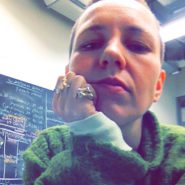
TAG Profiles is a blog series that explores the work of current TAG scholars. Ida Toft is a PhD student in Concordia’s INDI program.
What is the focus of your research-creation work in the INDI program at Concordia?
What I’m doing is taking a few topics and exploring them and weaving them together in ways that I think complements the research-creation. I often summarize my research-creation practice by saying that I explore how we can make games using computational vibration technologies. But research-creation is often much more messy than a single research question. Some of the topics I’m exploring are vibration technologies, haptics technologies, games and game structures, and art in public spaces. This also leads me into cybernetic structures, cognitive structures, AI machine learning, and these algorithmic structures that we live in (and with) and so forth. There is a solid feminist perspective behind all of this.
Part of the research-creation, for me, is that the making process is driving the topics that I am working with. So you can use research-creation to answer a research question or you can do a type of research-creation that comes from somewhere else — not necessarily a traditionally academic or intellectual place, or even rooted in a very clear question, but more of a response through art creation, which can come from a more ambiguous place.
One question I think a lot about right now is: “how does art-making then belong in academia?” There are, of course, specific historical, political, and economic reasons behind this question. For me, it also has to do with what conversations you want to be part of and respond to, and academic conversations and knowledge production is a field that happens to be interesting to me. Obviously this question is a big one and maybe I will have a more thorough answer in my dissertation.
When you mention vibrations and haptics, what form does that take?
In my work, it has mainly been as an output. I’ve been trying to work out how to make games using vibration technologies instead of screens, which is obviously a huge challenge. In a screen, you can communicate a lot of things that you cannot communicate with vibration technologies. And there are not the same kind of conventions! When you feel a vibration, there is not a set of fixed schematics for what things mean. So, it’s a bit of an impossible challenge that I gave myself.
Are you making games that involve these sort of feedbacks?
Yes, I made the game Promises that was shown at Ars Electronica this summer and later in Plovdiv, Bulgaria, as part of the Urban games festival Time Machine. I basically took sixteen vibrating objects and I made a local multiplayer game, where people are trading these objects in return for making promises to each other. For example, you could give conditions like: “okay, we can trade this, but only if you promise me that you’re gonna take good care of it.” And it could be both in game and out of game promises. For instance, I have played with families who are like “promise me that we will have a glass of wine tonight” or “promise me that we are not having any more fights today.”
Are there any particular scholars that influence your approach to research-creation?
I have been reading a lot of Donna Haraway, which is not really a template for what I’m doing, but I find her quite liberating. It’s wonderful for me to see the way she talks about research as being stories and how her research-stories create structures and theories that are easier to inhabit than the ones we are currently in/under. She’s a biologist and she was studying biology during the time cybernetic thinking was very dominate, and she is obviously a feminist with a very progressive outlook. So she’s trying to contemplate how we think about society and how that makes the everyday life of some people easier than for other people. For instance, when living in this patriarchal and very heteronormative world, life is harder for people with female appearing bodies and people who don’t have a heteronormative sexuality and so forth.
How that exactly relates to my research approach? I’m not sure. It was just very liberating for me because she’s quite bold in her work. And she doesn’t follow these rigid structures and instead talks about being accountable for what you make. You don’t have to follow the templates that academia has given you. You can do whatever you are you want to make, but you are held accountable to it. I think that fits with my approach to research-creation.
How does TAG help you realize the goals of your work?
I think that community is huge. Without community, I would not have survived in Montreal as an international student. Resources are also important, as well as having a place that is your anchor in the University, someplace you can always go to leave your bag and leave your jacket is really nice. It sounds so basic, but if you’re always carrying around your jacket and your bag, and you have no place to leave your belongings, you’re a nomad. TAG is like is my home at the university in that sense, it’s like this anchor. I can always go to TAG and there will be people I know and that’s really nice.
How can people follow you online?
I’m on Twitter at @idamarietoft, and you can find more information about Promises on the TAG blog.
